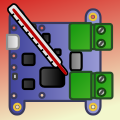About programming examples
![]() From time to time, Yoctopuce support receives emails from customers who complain that the examples provided with the Yoctopuce programming libraries don't work. We don't pretend to believe that our code is 100% error free, but it is clear that, most of the time, the problem comes from a misunderstanding about how these examples work. This week, we are going to clarify this issue.
From time to time, Yoctopuce support receives emails from customers who complain that the examples provided with the Yoctopuce programming libraries don't work. We don't pretend to believe that our code is 100% error free, but it is clear that, most of the time, the problem comes from a misunderstanding about how these examples work. This week, we are going to clarify this issue.
| No comment yet | Read more... |
How to get started in VB.NET with Yoctopuce modules
![]() This week, we add to our "for the beginners" series and we tackle Visual Basic .Net. We are going to write a small application displaying the values of a Yoctopuce sensor.
This week, we add to our "for the beginners" series and we tackle Visual Basic .Net. We are going to write a small application displaying the values of a Yoctopuce sensor.
| No comment yet | Read more... |
Device tests at very low temperatures
![]() Now that we finally have our small dry ice freezer, we were able to perform systematic measures of cold endurance for our sensors and transmitters. So here are the tests that we performed and the results.
Now that we finally have our small dry ice freezer, we were able to perform systematic measures of cold endurance for our sensors and transmitters. So here are the tests that we performed and the results.
| No comment yet | Read more... |
Cheap and compact cold
![]() Three weeks ago, we built a "hot box" that can maintain a small enclosure at a constant temperature in the order of 85░C during a few hours. This week, we are trying to do the opposite: a "cold box" that can maintain an ambient temperature in the order of -30░C.
Three weeks ago, we built a "hot box" that can maintain a small enclosure at a constant temperature in the order of 85░C during a few hours. This week, we are trying to do the opposite: a "cold box" that can maintain an ambient temperature in the order of -30░C.
| No comment yet | Read more... |
Temperature tests on Yoctopuce devices
 You may have noticed that until now our module specifications didn't include a working temperature range. This omission could seem strange, but we didn't want to give raw numbers without accompanying them with some explanations. Indeed, although most of the modules were designed for an extended temperature range, we hadn't had the opportunity to formally valid the theoretical temperatures. Thanks to the small system built two weeks ago, it's getting ready.
You may have noticed that until now our module specifications didn't include a working temperature range. This omission could seem strange, but we didn't want to give raw numbers without accompanying them with some explanations. Indeed, although most of the modules were designed for an extended temperature range, we hadn't had the opportunity to formally valid the theoretical temperatures. Thanks to the small system built two weeks ago, it's getting ready.
| No comment yet | Read more... |
1 ... 10 ... 20 ... 30 ... 40 ... 50 ... 60 ... 70 ... 79 80 81 82 83 84 85 86 87 88 89 90 ... 100 ... 110 ... 120 ... 130 ... 140 ... 150 151


